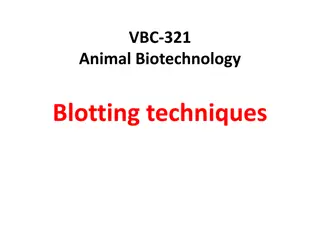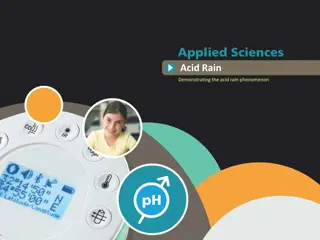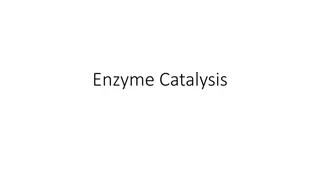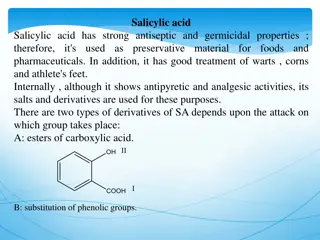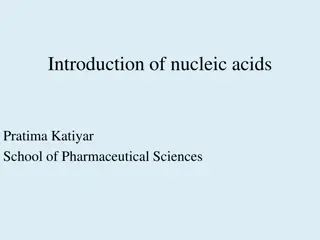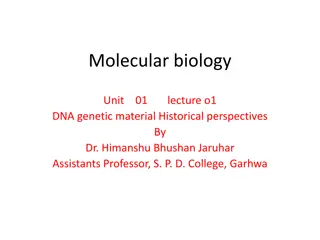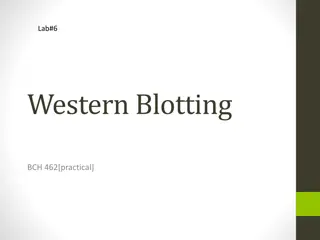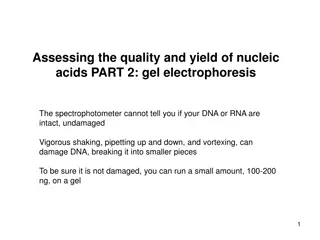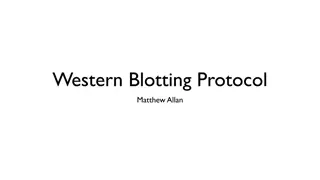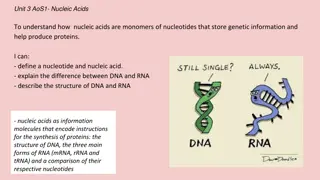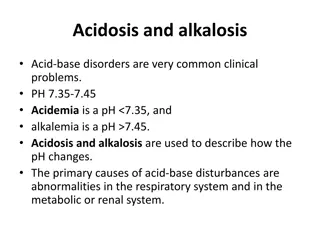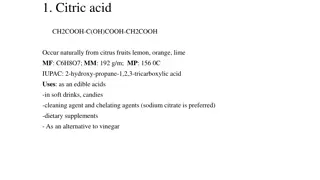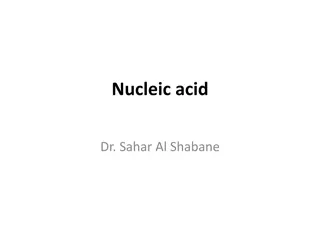Understanding Nucleic Acid Blotting: Southern Blotting Techniques
Nucleic acid blotting techniques, including Southern blotting, are crucial for transferring DNA, RNA, and proteins for analysis. Southern blotting, developed by Edwin Mellor Southern, is used to probe specific DNA sequences, aiding in applications such as gene isolation, DNA fingerprinting, and disease diagnosis. The principle involves DNA fragmentation, gel electrophoresis, membrane transfer, hybridization, and detection. Nylon membranes are preferred for their binding capacity and reusability in the process. Learn more about the application and principle of Southern blotting in genetic analysis.
Download Presentation

Please find below an Image/Link to download the presentation.
The content on the website is provided AS IS for your information and personal use only. It may not be sold, licensed, or shared on other websites without obtaining consent from the author. Download presentation by click this link. If you encounter any issues during the download, it is possible that the publisher has removed the file from their server.
E N D
Presentation Transcript
Genetic Engineering Third Grade
Nucleic Acid Blotting Blots are techniques for transferring DNA , RNA and proteins onto a carrier so they can be separated, and often follows the use of a gel electrophoresis. Nucleic Acid Blotting techniques There are four types of NucleicAcid Blotting techniques : 1-Southern blotting (used for transferring DNA) 2-Northern blotting (for RNA) 3-western blotting (for protein ) 4-Southwestern blotting (for characterization of proteins that bind DNA) 1-Southern blotting Historically, perhaps the oldest blotting method that we know today .Is a method used to transfer DNA from an agarose gel to a membrane, where the DNA can be subsequently probed for a specific sequence. The technique was named after its inventor, Edwin Mellor Southern, who developed the technique in Edinburgh, Scotland in 1975s .
Application of Southern blotting: Southern blot a technique developed for the detection of a specific DNA sequence (gene or other) in a large, complex sample of DNA (e.g. cellular DNA). For example, Southern blotting could be used to locate a particular gene within an entire genome. More of its applications are listed below: 1-Southern blotting technique is used to isolate and identify desire gene of interest. 2-DNAfinger printing is an example of southern blotting. 3-Used for paternity testing, criminal identification, victim identification. 4-Used in restriction fragment length polymorphism. 5-To identify mutation or gene rearrangement in the sequence of DNA. 6-Used in diagnosis of disease caused by genetic defects( such as: Sickle-cell anemia, Thalassemias, Hemophilia and dwarfism) 7-Used to identify infectious agents.
Principle of Southern blot: The Southern blotting method essentially involves the digestion of the DNA with a restriction enzyme, giving a mixture of DNA fragments of different sizes, which produces a bands when run on agarose gel electrophoresis. The DNA thus separated in the gel is then denatured by an alkaline treatment so that the DNA can be dissociated into single strands that can then be hybridized to the probes. The DNA is then transferred from the agarose gel to a (nylon) membrane and cross- linked, that is, immobilized. This membrane is then treated with a (usually radiolabeled) probe, which recognizes and hybridizes with homologous sequences. The membrane is washed to get rid of excess probe and exposed to film or a phosphorimager cassette, after which the bands are visualized at the sites of hybridization.
DNA transferring membranes Traditionally, a nitrocellulose membrane is used, although nylon or a positively charged nylon membrane may be used. Nitrocellulose typically has a binding capacity of about 100 g/cm, while nylon has a binding capacity of about 500 g/cm. Many scientists feel nylon is better since it binds more and is less fragile. Nylon membranes cannot be damaged by handling and a single blot can be rehybridized up to ten times, this limit being due not to eventual breakage of the membrane but to the gradual loss of the blotted DNA during repeated hybridizations. The second advantage of nylon membranes is that under certain conditions (a positively charged membrane and an alkaline transfer buffer) the transferred DNA becomes covalently bound to the membrane during the transfer process. This is not the case with a nitrocellulose membrane, which initially binds DNA in a semipermanent manner, immobilization occurring only when the membrane is baked at 80 C. Transfer onto a positively charged nylon membrane can therefore reduce the possible loss of DNA that might occur by leaching through the membrane during the blotting process; it is also quicker, the transfer time being reduced from 18 h to 2 h. Finally, nylon membranes efficiently bind DNA fragments down to 50 bp in length, whereas nitrocellulose membranes are effective only with molecules longer than 500 bp. Nitrocellulose has not, however, been completely superseded because it has one significant advantage compared with nylon membranes: a reduced amount of background hybridization, especially with probes that have been labelled with nonradioactive markers.
Steps involved in Southern blotting 1. Sample preparation: Digest the DNA with an appropriate restriction enzyme. 2. Gel Electrophoresis: Run the digest on an agarose gel. 3. Denaturation: After electrophoresis, denature the DNA (usually while it is still on the gel) by heat or chemically by soaked the gel in alkali (NaOH) or acid (HCl) to denature the double stranded DNA fragments into single-stranded DNA. Only ssDNA can transfer to membrane. 4. Blotting: Transfer the denatured DNA to the membrane. (Nylon membranes or nitrocellulose). Transfer is usually done by capillary action, which takes several hours. Capillary action transfer draws the buffer up by capillary action through the gel an into the membrane, which will bind ssDNA. You may use a vacuum blot apparatus instead of capillary action. In this procedure, a vacuum sucks ssDNAs through the membrane. This works similarly to capillary action, except more ssDNAs goes through the gel and membrane, so it is faster (about an hour).
5-Baking: After the DNA of interest bound on the membrane, it is baked by treating it with UV light or by heat (For nylon membranes, the DNA is crosslinked to the membrane by the action of ultraviolet light; nitrocellulose membranes use heat to fix the DNA to the membrane). 6-Hybridization with labelled probes: Hybridization is process of forming a double-stranded DNA molecule between a single-stranded DNA probe and a single- stranded target patient DNA .A hybridization probe is a short (100500bp), single stranded DNA/or RNA. The probes are labeled with a marker (radiolabeled 32P probe) so that they can be detected after hybridization. 7-Visualization by Autoradiogram: The membrane bound DNA labelled with probe can be visualized under autoradiogram which give pattern of bands.
Northern blotting Northern blotting was developed by James Alwine, George Stark and David Kemp (1977). Northern blotting drives its name because of its similarity to the first blotting technique. The major difference is that RNA being analyzed rather than DNA in the northern blot. Expression of a particular gene can be detected by estimating the corresponding mRNA by Northern blotting. Northern blotting is a technique where RNA fragments are separated by electrophoresis and immobilized on a paper sheet. Identification of a specific RNA is then done by hybridization using a labeled nucleic acid probe. It helps to study gene expression by detection of RNA (or isolated mRNA) in a sample. In Northern blotting, probes formed of nucleic acids with a sequence which is complementary to the sequence or to a part of the RNA of interest. The probe can be DNA, RNA or chemically synthesized oligonucleotides of minimum 25 complementary bases to the target sequence.
Western blotting Western blotting, also known as immunoblotting or protein blotting, is a technique used to detect the presence of a specific protein in a complex protein mixture. It is a core technique in cell biology, molecular biology, virology and others. Western blots have become one of the most common analytical tools for the Detection of viral proteins, characterization of monoclonal and Polyclonal antibody preparations and in determining the specificity of the immune response to viral antigens.



